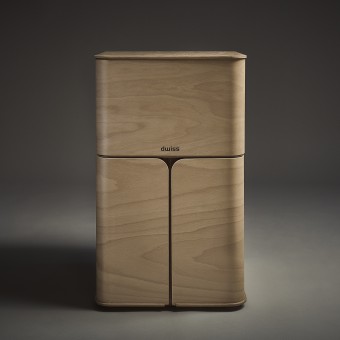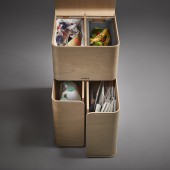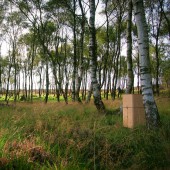DWISS Recycling bin by Jon Walker and Paul Timmer |
Home > Winners > #57475 |
 |
|
||||
| DESIGN DETAILS | |||||
| DESIGN NAME: DWISS PRIMARY FUNCTION: Recycling bin INSPIRATION: The dwiss was developed in response to my own needs when I started recycling and found I had piles of different waste types around the kitchen - I wanted a recycling bin that looked good, worked well and was itself a sustainable product. The prototype trials confirmed the dwiss provides an excellent solution. People inspired me to recycle - it helps give them a fair chance in life by preserving a healthy environment in which to live. The dwiss symbolises the circular economy. UNIQUE PROPERTIES / PROJECT DESCRIPTION: To support the Circular Economy the dwiss has a sustainable design and promotes recycling by making it quick and easy. It is made from plywood, which is a finite and carbon neutral material. It's innovative 'frame and compartment' design minimises the quantity of plywood required. Mechanical parts have been avoided to increase durability and the dwiss has been constructed in a way that enables maintenance over the years to come. The dwiss has 4 compartments, including 1 for non-recyclables. OPERATION / FLOW / INTERACTION: The dwiss is easy to use to eliminate a reason why people do not recycle - because it is too difficult. The lid is raised to just past vertical, providing access to 1 compartment for non-recyclables that can be discreetly fitted with a bag, and a second compartment that houses a removable composting tub that can be transferred to the worktop when preparing food. The two lower compartments simply slide out and can be carried in one hand, leaving the other free to open the door when emptying. PROJECT DURATION AND LOCATION: The project started in 2005 in Sheffield when Jon Walker needed a bin to help him recycle and produced the initial sketches of the dwiss. It finished in 2016 in Amsterdam when Paul Timmer completed the design following multiple prototype trials. |
PRODUCTION / REALIZATION TECHNOLOGY: The design of the dwiss was driven by resource optimisation - how to get the most value from the least material. So the parts that provide function also provide form - the dwiss is single skin with an innovative 'frame and compartment' design. To resolve issues we took away rather than adding. We avoiding mechanical parts that might fail - there is only a single hinge for the lid. The material we chose is Beech plywood, a durable, infinite, carbon-neutral material that is easy to recycle. SPECIFICATIONS / TECHNICAL PROPERTIES: Overall the dwiss is 41 / 43 / 67cm w/h/d. Despite this modest size, due to its innovative 'frame and compartment' design the dwiss provides industry leading capacity at over 80 litres / 17 gallons. TAGS: dwiss, Paul Timmer, Sustainable Design, Design Thinking, Rapid Prototyping, Circular Economy, Plywood, Durable RESEARCH ABSTRACT: Jon Walker identified a need and conducted field research to establish whether other people had the same need. Jon Walker then produced some initial sketches that were developed into CAD drawings to aid communication. Market research and desktop studies were then undertaken to establish competition and applicable legislation, e.g. the EU Waste Framework Directive. Rapid prototyping was then undertaken, with the feedback collated, analysed and used as an input into the final design brief. CHALLENGE: When resolving problems we removed, resulting in a relatively small number of highly functional, highly engineered wooden parts. Designing these in a way that supported economically viable mass production was the biggest challenge. ADDED DATE: 2017-04-04 16:13:00 TEAM MEMBERS (7) : Paul Timmer, Heeth Read, Anthony Jones, Matt Willox, Eve Ballie, James Dykes and Liam Swift IMAGE CREDITS: Image #1: Photographer James Brown Image #2: Photographer James Brown Image #3: Photographer James Brown Image #4: Photographer James Brown Image #5: Photographer James Brown Video: Videographer Matobo PATENTS/COPYRIGHTS: Patented. GB2435405. Jonathan Walker. UK |
||||
| Visit the following page to learn more: http://www.yourdwiss.com | |||||
| AWARD DETAILS | |
 |
Dwiss Recycling Bin by Jon Walker and Paul Timmer is Winner in Furniture Design Category, 2016 - 2017.· Read the interview with designer Jon Walker and Paul Timmer for design DWISS here.· Press Members: Login or Register to request an exclusive interview with Jon Walker and Paul Timmer. · Click here to register inorder to view the profile and other works by Jon Walker and Paul Timmer. |
| SOCIAL |
| + Add to Likes / Favorites | Send to My Email | Comment | Testimonials | View Press-Release | Press Kit |
Did you like Jon Walker and Paul Timmer's Furniture Design?
You will most likely enjoy other award winning furniture design as well.
Click here to view more Award Winning Furniture Design.








